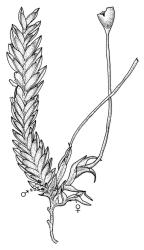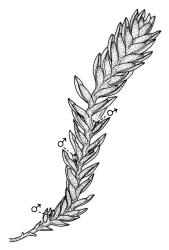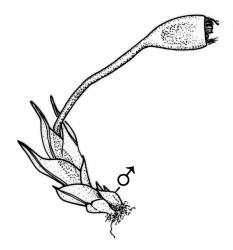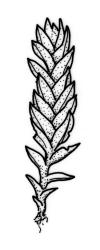- ≡ Fissidens pygmaeus Taylor, London J. Bot. 5: 66 (1846) nom. illeg., non Fissidens pygmaeus Hornsch. 1841
- = Fissidens ramiger Beckett, Trans. & Proc. New Zealand Inst. 25: 294 (1893)
Plants heteromorphic, 2–10 mm, pale green, in scattered clusters. Stems simple or branched, with rhizoids at base of main stem and branches. Leaves in 8–25 pairs, erecto-patent, plane when moist, little altered when dry, oblong to lanceolate, 0.3–1.0 × 0.1–0.3 mm; apex acute to obtuse; laminae unistratose; vaginant laminae ⅔–⅘ leaf length, half to almost closed; dorsal lamina narrow and failing above leaf insertion, tapered to its base; margins entire to minutely serrulate; marginal cells on vaginant laminae in one to several rows, elongate and prosenchymatous forming a weak unistratose border, or leaf margins unbordered; cells of apical and dorsal laminae irregularly quadrate to hexagonal, smooth, non-bulging, with thin to firm walls, 6–23 × 6–12 µm. Costa subpercurrent to excurrent, bryoides-type in cross-section.
Polyoicous. Perichaetial leaves 1.0–1.5 mm, apical lamina narrow, dorsal lamina narrow, failing well above leaf insertion, tapered to its base; vaginant laminae inflated, usually bordered. Setae 2–6(–8) mm; capsules erect to inclined, symmetric; operculum rostellate from a conic base, ⅓–½ the length of theca. Peristome bryoides-type or sainsburia-type (in var. sainsburyanus). Calyptra smooth, cucullate (not seen in var. epiphytus). Spores 15–36 µm.
The species is distinguished from other minute and soil-inhabiting Fissidens found in N.Z. by the following combination of characters: large, smooth lamina cells, the leaf border (when present) being confined to the vaginant laminae (except in very rare cases when a trace of border is present on the dorsal lamina), symmetric capsules, and the highly variable arrangement of sex organs. In all cases gametoecia consist of unisexual modified short shoots with terminal gametangia. The gametoecia may be axillary on otherwise sterile leafy shoots, either laterally or at the base, but are never terminal. They may be connected to a sterile shoot by rhizoids, or they may be apparently independent. In addition, male gametoecia may occur at the base of a female shoot. The peristome is distinctive (at least in N.Z. varieties) in having shallow, rather than deep, adaxial trabeculae in the supra-basal region of the teeth.
Although the dorsal lamina of both vegetative and perichaetial leaves is frequently much less developed in F. taylorii s.l. than in other species, vegetative plants cannot be distinguished with certainty from those of F. curvatus var. inclinabilis.
Fissidens taylorii s.l. grows exclusively on soil, in mesic to xeric habitats. The species is widespread through the drier and more eastern parts of the North and South Is.
| Category | Number |
|---|---|
| Indigenous (Non-endemic) | 3 |
| Total | 3 |
For distribution and habitat see the varieties.
Distinctions from F. curvatus var. inclinabilis are discussed under the latter taxon.
An account of F. taylorii s.l. in Australasia was given by Stone & Beever (1996).








